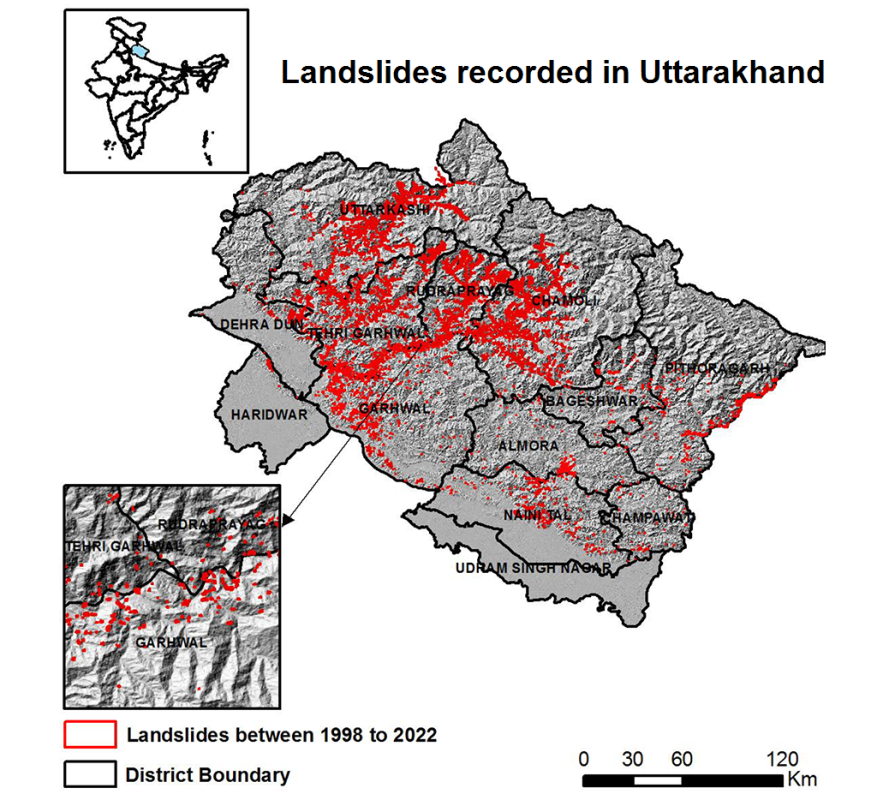Description

Disclaimer: Copyright infringement not intended.
Context
- Over 180 Adi pilgrims were rescued when returning from the pilgrimage on their way to Adi Kailash and were route from Gunji to Dharchula base camp.
- They were stranded in the middle as landslide washed off a road stretch of length nearly 100 metres in Pithoragarh district.
- A medical team and a joint team of SDRF, SSB and police were sent to rescue them and to assure the well beings of pilgrims.
About Adi Kailash
- Adi Kailash is a holy mountain of Himalayan range located in the Pithoragarh district in the state of Uttarakhand.
- The route along the Sharda River at Gunji in Pithoragarh leads to Adi Kailash which is 38 km from Gunji.
- It is also known as Shiva Kailash, Chota (little) Kailash, Baba Kailash or Jonglingkong Peak.
- It has a height of 6321 Mts and is considered as a replica of Mount Kailash, which is the abode of Lord Shiva, goddess Parvati and their offspring Ganpati and Kartikey.
- It holds significance to Sanatana religion as it is considered sacred and hence a popular pilgrimage of Shiva devotees.
- According to mythological text, Puranas, it is believed to be the main stop of Shiva’s marriage.
Vulnerability of Uttrakhand to Landslides
- According to satellite data by the Indian Space Research Organisation (ISRO), Rudraprayag and Tehri Garhwal in Uttarakhand are the most landslide-prone districts in the country.
- Uttarakhand also has 500 land slide prone zones in Alaknanda Valley.
- A study by Wadia Institute of Himalayan Geology (WIHG) in Dehradun reaffirms the same. It says that 51% of Uttarakhand falls under 'high' and 'very high' landslide susceptible zones.

LandSlide
- Landslide, also called landslip, the movement of a mass of rock, debris, earth, or soil down a slope.
- Landslides, which are a type of mass wasting, are one of the major hydro-geological hazards that affect large parts of India besides the Himalayas, Western and Eastern Ghats. It affects around 15% of landmass.
|
Mass Wasting
Mass wasting refers to any down-slope movement of soil and rock under the direct influence of gravity.
|
Causes of Landslide
- There are three various causes of landslides, most of them are listed below -
- Natural causes like Earthquakes
- Excessive rainfall
- Melting of snow,
- Changes in water level of rivers, lakes and ground water
- Soil erosion
- Excessive and unregulated grazing
- Deforestation
- Dam, roads and other construction activities by humans
Landslide mitigation and prevention
- Hazards should be mitigated usually through precautionary means which are –
- Keeping a safe zone and restrict the residence, construction and other human activities in landslide prone areas.
- Installation of early warning systems and dissemination of information based on regular monitoring of rocks, soil and ground conditions.
- Modification of slope geometry and Reinforcing slope material.
- Installing structures such as poles, fence/retaining walls to minimize impact of landslide.
- Diverting debris pathways.
|
PRACTICE QUESTION
Q) There is an increase in the occurrence of disasters like landslides in India. Enumerating reasons for this phenomena, discuss the measures which could be taken to mitigate the impact of landslides. (250 words)
|

Sources: https://www.hindustantimes.com/cities/dehradun-news/over-180-adi-kailash-pilgrims-rescued-from-landslide-in-uttarakhand-by-joint-sdrf-ssb-and-revenue-police-team-101685713225477.html

















